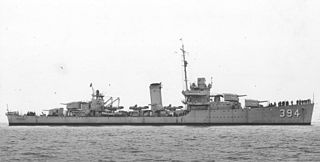
USS PC-815 was a PC-461-class submarine chaser built for the United States Navy during World War II. Its first commander, for about eighty days in 1943, was L. Ron Hubbard, who later became the founder of Scientology. After Hubbard was removed from command for conducting unauthorized gunnery practice in Mexican territorial waters, the PC-815 served as a shore patrol vessel off San Diego, California.
The second USS Sapphire (PYc-2) was a patrol boat in the United States Navy.

USS Meredith (DD-434), a Gleaves-class destroyer, was the second ship of the United States Navy to be named for Jonathan Meredith, a United States Marine Corps sergeant who served during the First Barbary War.

The second USS Sampson (DD-394) was a Somers-class destroyer in the United States Navy. She was named of William Thomas Sampson a rear admiral known for his victory in the Battle of Santiago de Cuba during the Spanish–American War.

USS Crouter (DE-11) was an Evarts-class destroyer escort of the United States Navy in commission from 1943 to 1945. The ship was named after Mark Hanna Crouter (1897–1942), U.S. Navy officer and Navy Cross recipient.

The military career of L. Ron Hubbard saw the future founder of Scientology serving in the United States Armed Forces as a member of the Marine Corps Reserve and, between 1941–50, the Navy Reserve. He saw active service between 1941–45, during World War II, as a naval Lieutenant and later as a Lieutenant. After the war he was mustered out of active service and resigned his commission in 1950.

USS Edithena was a United States Navy patrol vessel in commission from 1917 to 1919 that saw service during World War I. Prior to her U.S. Navy service, she operated as the private motor yacht Edithena from 1914 to 1917. After the conclusion World War I, she served as the fishery patrol vessel USFS Widgeon in the fleet of the United States Bureau of Fisheries from 1919 to 1940 and as US FWS Widgeon in the fleet of the Fish and Wildlife Service from 1940 to 1942. During World War II, she returned to U.S. Navy service from 1942 to 1944 as the yard patrol boat USS YP-200. By 1947 she had returned to private ownership, first as Edithena and during the 1970s and 1980s as the fishing vessel Ila Mae.
USS PC-465 was a PC-461-class submarine chaser built for the United States Navy during World War II. She was later renamed Paragould (PC-465) but never saw active service under that name. In 1961 she was transferred to the Venezuelan Navy under the name ARV Pulpo (P-7). She remained active in Venezuelan service until 1968, when she was placed in reserve. She was stricken in 1978 but her ultimate fate is unknown.

USS Wanderlust (SP-923) was a patrol vessel that served in the United States Navy from 1917 to 1919.

The first USS Orca (SP-726) was a yacht that served in the United States Navy as a patrol vessel from 1917 to 1918.
The first USS Lydia (SP-62) was an armed motorboat that served in the United States Navy as a patrol vessel from 1917 to 1919.

USS De Grasse (ID-1217) was the projected name for an armed yacht that the United States Navy acquired for service as a patrol vessel in 1918 but, according to some sources, never commissioned, although other sources claim she saw brief naval service in 1918. In World War II, she was reacquired and served as YP-506. The yacht's official number was registered under the name Fleet as of 1959, fate unknown.

USS Eaglet (SP-909), later redesignated YP-909, was an armed motorboat that served in the United States Navy as a patrol vessel from 1917 to 1921.

George Lawley & Son was a shipbuilding firm operating in Massachusetts from 1866 to 1945. It began in Scituate, then moved to Boston. After founder George Lawley (1823–1915) retired in 1890, his son, grandson and great-grandson upheld the business, which continued until 1945. Of the hundreds of ships built by the Lawleys, highlights include the yachts Puritan and Mayflower, respective winners of the 1885 and 1886 America's Cup.
USS PC-1230 was a Patrol Craft, laid down in 1942, participating in escort and convoy missions in the Pacific in World War II, and performed harbor control duties during the Battle of Peleliu.

USS Vencedor (SP-669) was a United States Navy patrol vessel in commission from 1917 to 1918.

USS Sylph (PY-12), briefly YP-71, was a yacht in commission in the United States Navy as a patrol yacht from 1940 to 1946.

This is a timeline of L. Ron Hubbard, founder of Scientology.

The USS YP-72 (ex-Cavalcade) was a converted fishing vessel which served as an auxiliary patrol boat in the U.S. Navy during World War II.

The USS YP-73 (ex-Corsair) was a converted fishing vessel which served as an auxiliary patrol boat in the U.S. Navy during World War II.
















